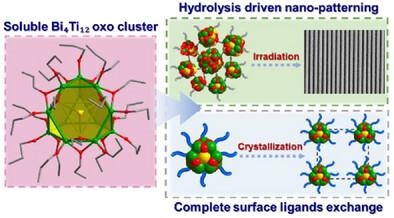Irradiation Accelerated Hydrolysis of Soluble Keplerate Titanium–Bismuth Oxo Clusters with Complete Surface Ligands Exchange Behavior for Direct Oxides Nanopatterning
IF 12.1
2区 材料科学
Q1 CHEMISTRY, MULTIDISCIPLINARY
引用次数: 0
Abstract
Controlled hydrolysis of metal oxo clusters has been first applied as a direct nanopatterning strategy for oxide materials. A heterometallic Bi4Ti12 oxo cluster is constructed with Keplerian-type architecture as a molecular platform for post-synthetic reactivity studies. Detailed mass spectrometry analysis confirms its exceptional dissolution stability and complete surface alkoxy ligands exchangeability. Interestingly, spin-coated thin films of Bi4Ti12 oxo clusters exhibit significant solubility contrast after ambient condition hydrolysis. Accordingly, electron-beam irradiation is applied to accelerate the cluster hydrolysis in exposed areas to enable fine lines patterning, with the hydrolysis-condensation pathways of irradiated Bi4Ti12 oxo clusters being demonstrated by comparative spectroscopic analyses. Finally, 20 nm critical dimension (CD) lines can be fabricated using this method under an expose energy of 130 µCcm−2. Therefore, this work not only constructs a Keplerate cluster family with interesting complete surface ligand exchange behavior, but also provides a new metal hydrolysis-driven lithography strategy for the direct patterning of metal oxide nanostructures.

辐照加速可溶Keplerate钛铋氧簇的水解,具有完全的表面配体交换行为,用于直接氧化物纳米图
金属氧簇的受控水解已首次应用于氧化物材料的直接纳米化策略。以开普勒型结构构建了异质金属Bi4Ti12氧簇,作为合成后反应性研究的分子平台。详细的质谱分析证实了其卓越的溶解稳定性和完全的表面烷氧基配体交换性。有趣的是,自旋涂覆的Bi4Ti12氧簇薄膜在环境条件下水解后表现出显著的溶解度差异。因此,应用电子束辐照来加速暴露区域的团簇水解,以实现精细的线条图案,并通过比较光谱分析证明了辐照的Bi4Ti12氧簇的水解-缩合途径。最后,在130µCcm−2的曝光能量下,利用该方法可以制备出20 nm的临界尺寸(CD)线。因此,本工作不仅构建了具有有趣的完整表面配体交换行为的Keplerate簇族,而且为金属氧化物纳米结构的直接图案化提供了一种新的金属水解驱动光刻策略。
本文章由计算机程序翻译,如有差异,请以英文原文为准。
求助全文
约1分钟内获得全文
求助全文
来源期刊

Small
工程技术-材料科学:综合
CiteScore
17.70
自引率
3.80%
发文量
1830
审稿时长
2.1 months
期刊介绍:
Small serves as an exceptional platform for both experimental and theoretical studies in fundamental and applied interdisciplinary research at the nano- and microscale. The journal offers a compelling mix of peer-reviewed Research Articles, Reviews, Perspectives, and Comments.
With a remarkable 2022 Journal Impact Factor of 13.3 (Journal Citation Reports from Clarivate Analytics, 2023), Small remains among the top multidisciplinary journals, covering a wide range of topics at the interface of materials science, chemistry, physics, engineering, medicine, and biology.
Small's readership includes biochemists, biologists, biomedical scientists, chemists, engineers, information technologists, materials scientists, physicists, and theoreticians alike.
 求助内容:
求助内容: 应助结果提醒方式:
应助结果提醒方式:


